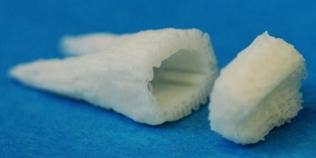Body’s Own Stem Cells Used To Grow Teeth in Mouth

Share
Researchers at Columbia University Medical Center may have found a way to replace missing teeth by having them regrown by stem cells in your mouth. Jeremy Mao, director of the Tissue Engineering and Regenerative Medicine Lab (TERML), used tooth shaped scaffolds augmented with growth factors and proteins to attract stem cells from the body and grow the appropriate bone in place in just 9 weeks. The work was performed in rats using both rat and human-based scaffolds and was reported in the Journal of Dental Research. While still very preliminary, Mao's results show that we may have the potential to regrow teeth lost to trauma or disease. Chalk up another win for regenerative medicine in the fight to repair long term damage to the human body.
We've been talking about using stem cells to grow new organs for years now, but that is typically in the context of the tissue being generated in a lab, such as when Columbia University grew a jawbone. A recent trend towards in vivo studies are newer and very promising. A boy in England had a new trachea grown in his throat using a scaffold and his own stem cells. The in-body approach has some major benefits including quicker integration and cheaper production. TERML's work stands out not just because it is in vivo, but also because it requires no culturing of stem cells. The mysenchemal cells in the body are attracted to the scaffold site by growth factors and proteins. This means that one day you may be able to pop in a scaffold in your tooth socket and your body will just grow a new tooth onto it.
But we're still a long way from that day. First and foremost, we should be cautious because TERML's recent study was in an animal model. Scaffolds for 22 rat incisors and human molars were made from polymers and calcium-based minerals using 3D bio-printing. The incisor scaffolds were placed in the rat's mouth (after extracting the natural one) while the human molars were surgically inserted into the back. (Animal testing never sounds pleasant, does it?) Even if the same scaffolds were to work perfectly in humans, we'd still be faced with years of human trials and safety evaluations. Secondly, while tooth cells were grown at the interface of the scaffold after 9 weeks, this is far from regenerating an entire tooth. It may take several rounds of engineering to find a way to induce cells to recreate the dentin, pulp, enamel, etc of an adult tooth.
Be Part of the Future
Sign up to receive top stories about groundbreaking technologies and visionary thinkers from SingularityHub.


Still, the scaffolds themselves have a lot promise - perhaps even bankable potential. Columbia has pursued a patent on the work, and TechVentures is actively seeking investors. The polymer/mineral structure of the scaffold may be something that could be adopted elsewhere. The growth factor (SDF1) and protein (BMP7) were shown to have significant effect in the attraction of stem cells to the site, so we're likely to see those applied in other places as well. If the overall scaffold does show success in growing teeth then chances are it could be modified for use in orthopedic endeavors as well.
At first glance, the TERML research may seem very specific, and to some degree it is. Mao and his colleagues are looking for the best way to replace missing teeth. Yet the applications for in vivo generation using stem cells is epic. If the appropriate scaffold and growth factors could be made, you could find ways to regenerate tissue almost anywhere in the body. To some extent we've already seen this with ACell and CookBiotech. TERML raises the possibility of regenerating entire complex structures. We may one day be able to regrow a tooth in place, or replace cartilage in a knee, or maybe even heal damage to hearing (by targeting the small inner ear structures). We're still years from such applications making their way to you, but they no longer seem like science fiction. Eventually the practice of implanting fake teeth, caps, and crowns will seem arcane. If it doesn't already.
[image credit: Jeremy Mao, Columbia University]
[source: Columbia University Medical Center News, Kim et al JDR, 2010]
Related Articles

This Light-Powered AI Chip Is 100x Faster Than a Top Nvidia GPU

This Week’s Awesome Tech Stories From Around the Web (Through December 20)

Data Centers in Space: Will 2027 Really Be the Year AI Goes to Orbit?
What we’re reading
